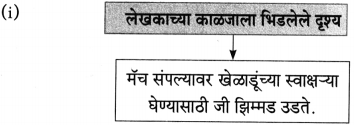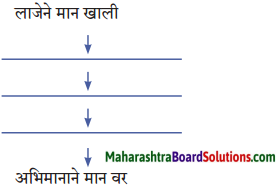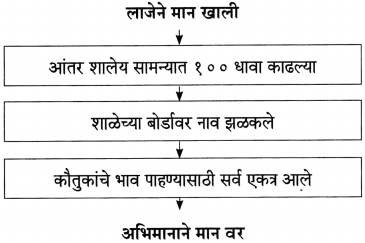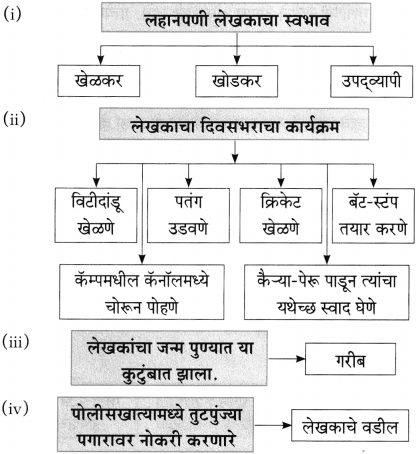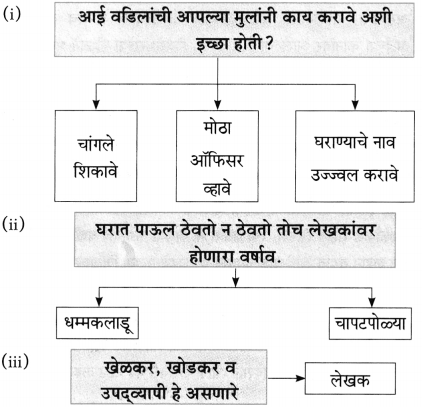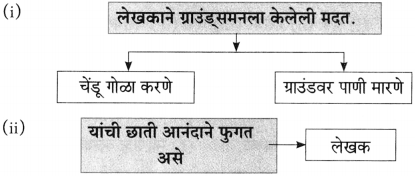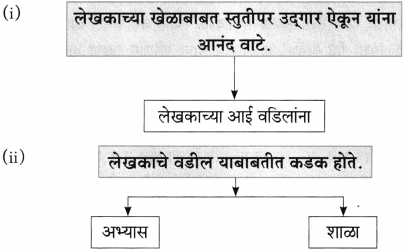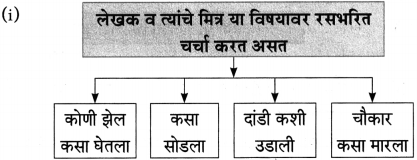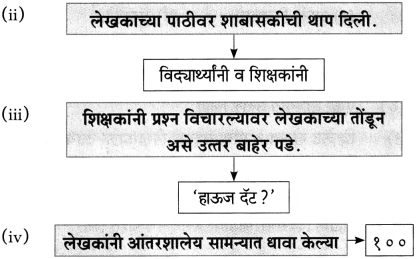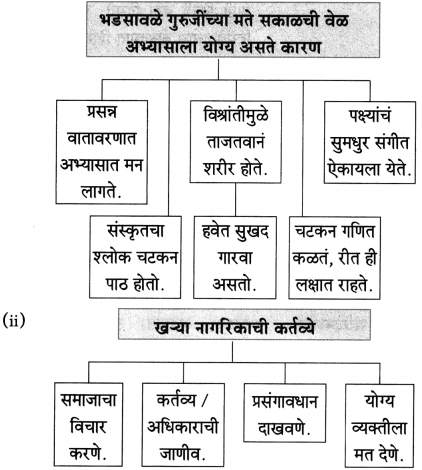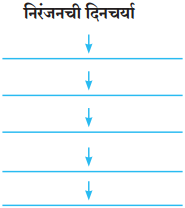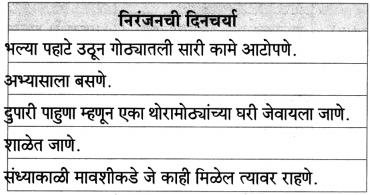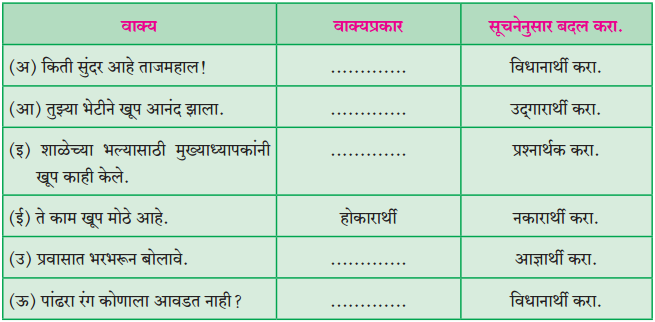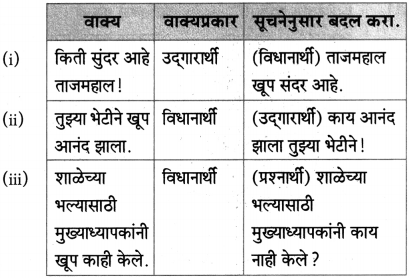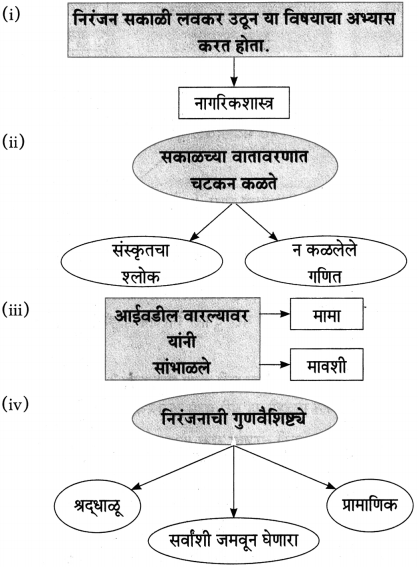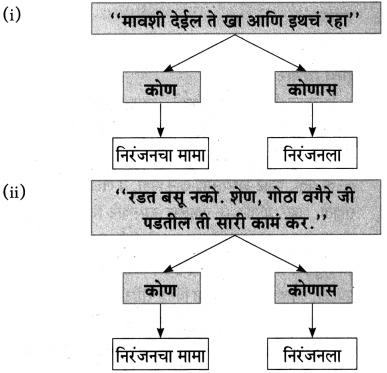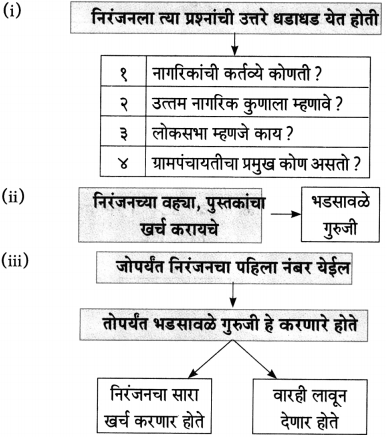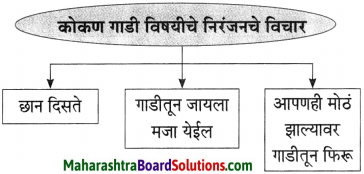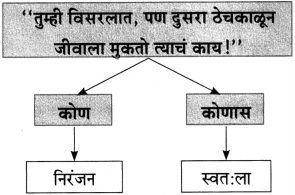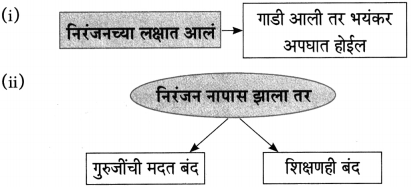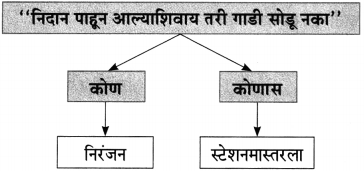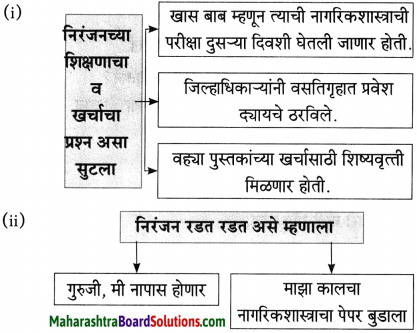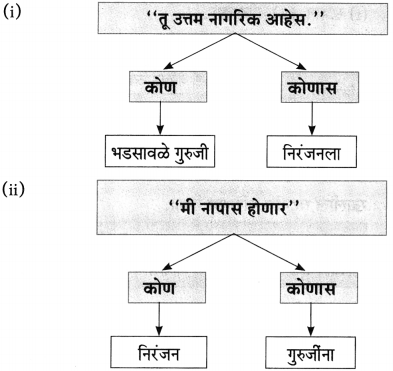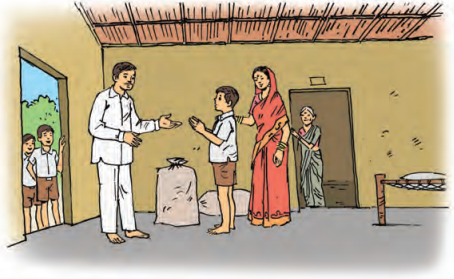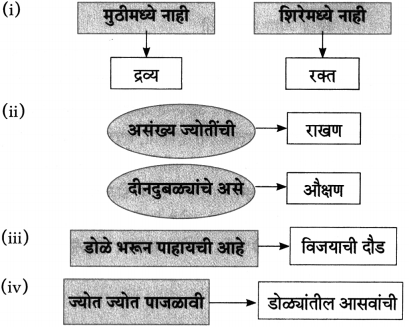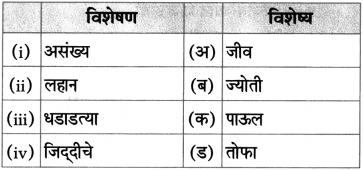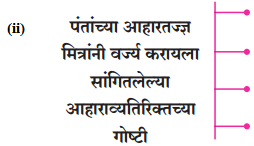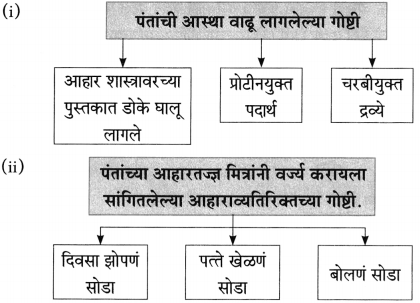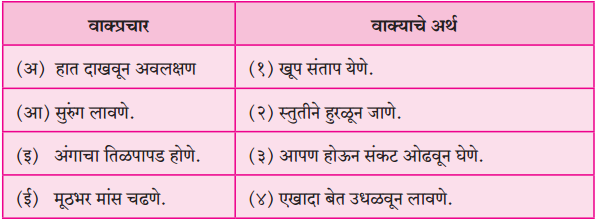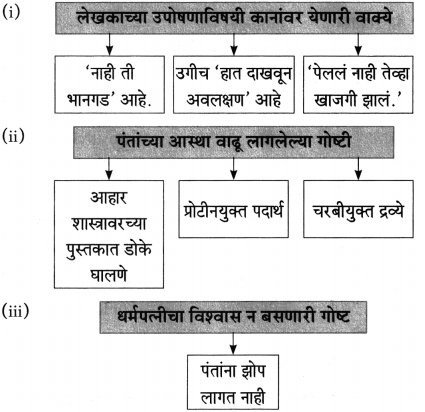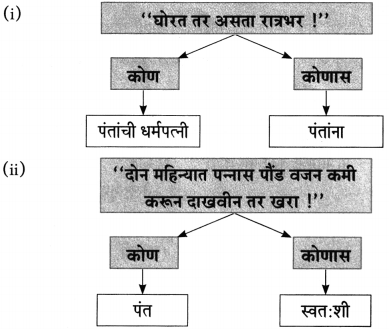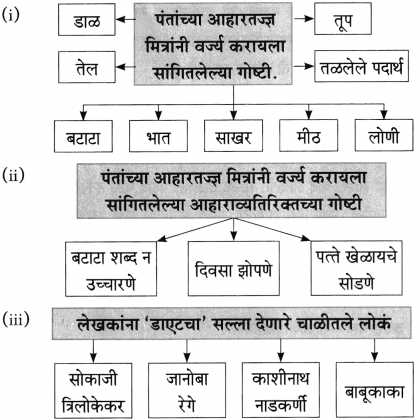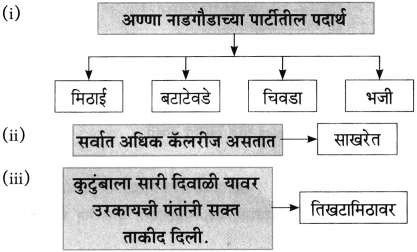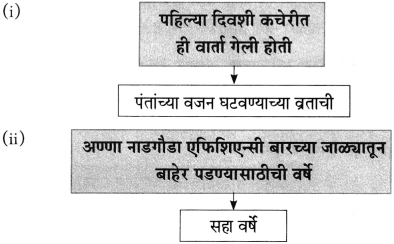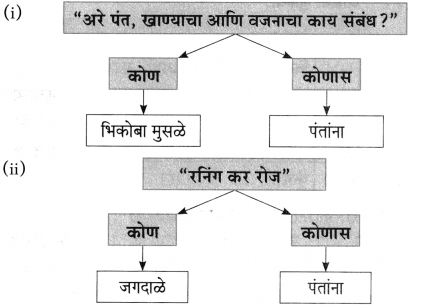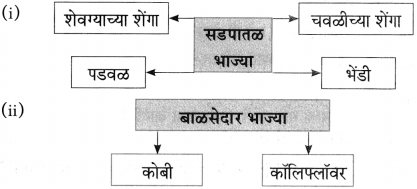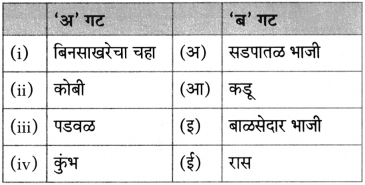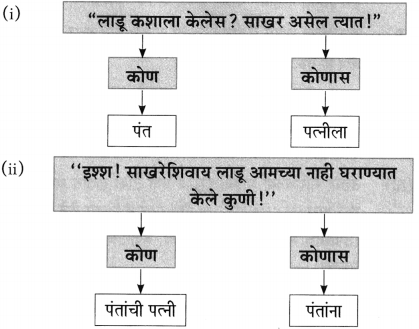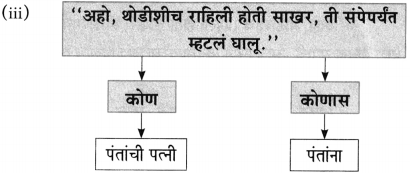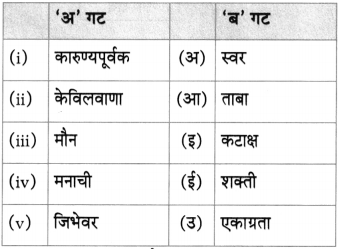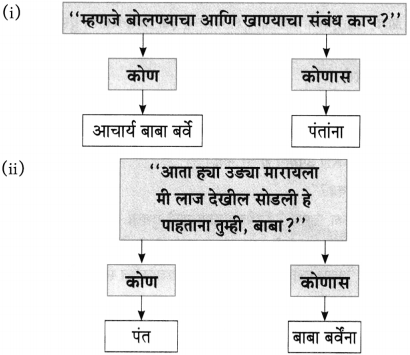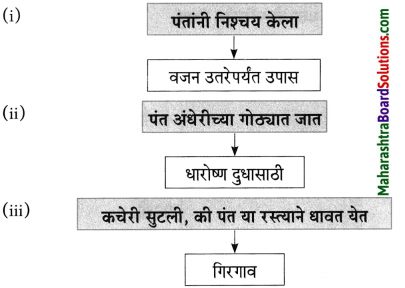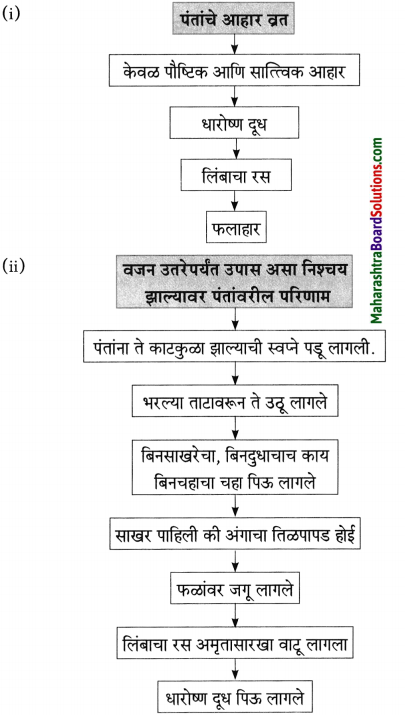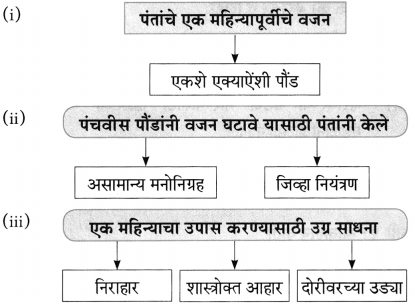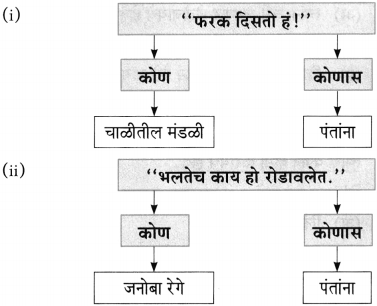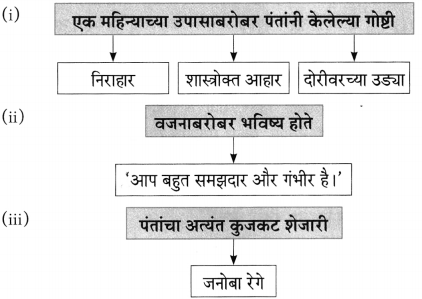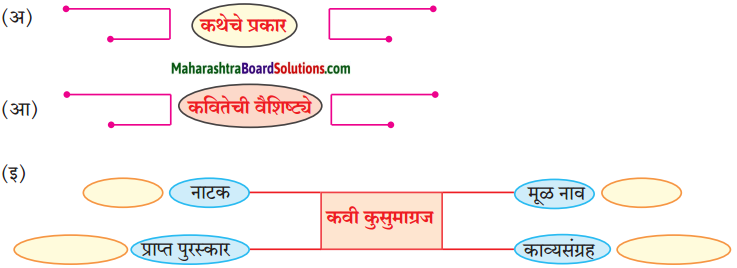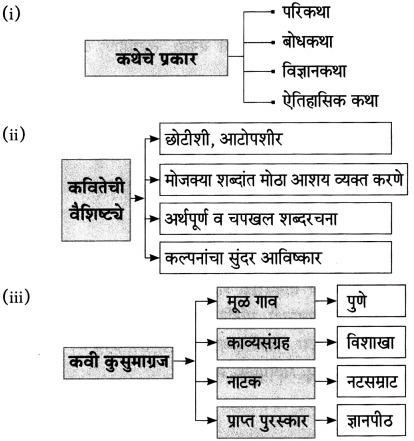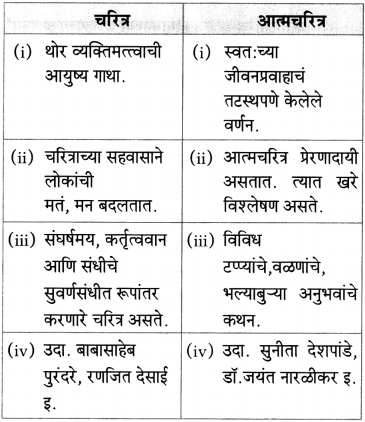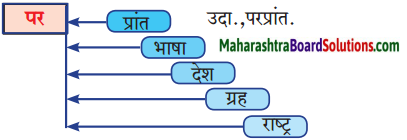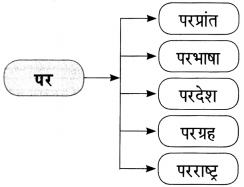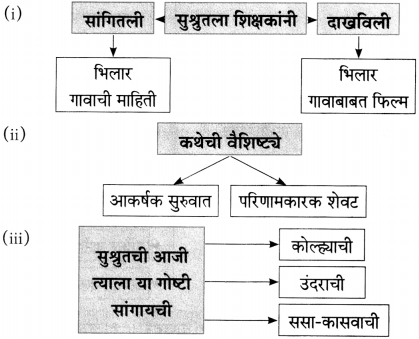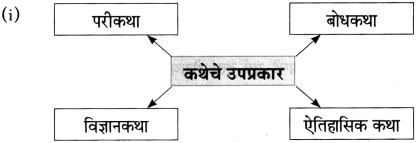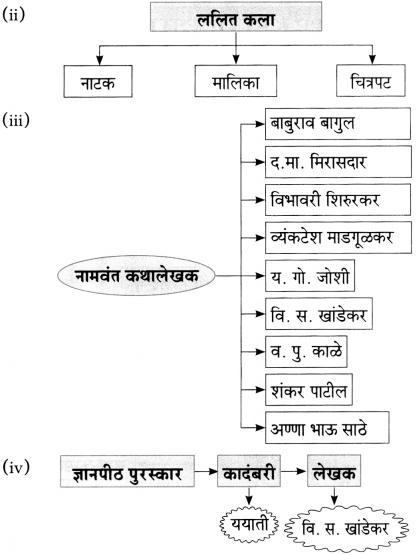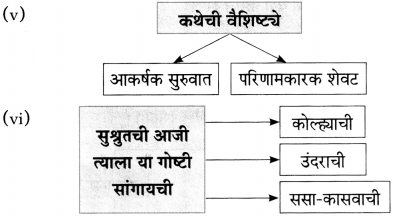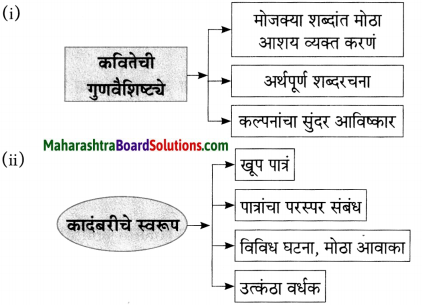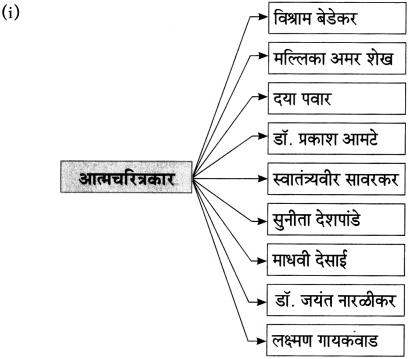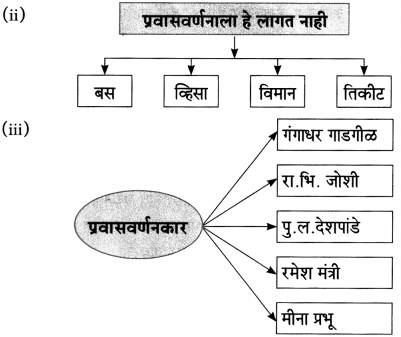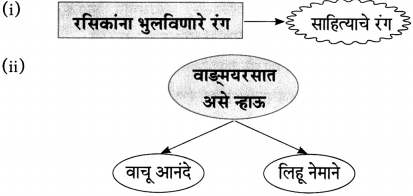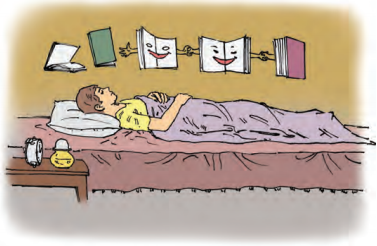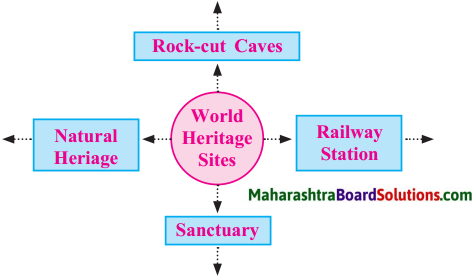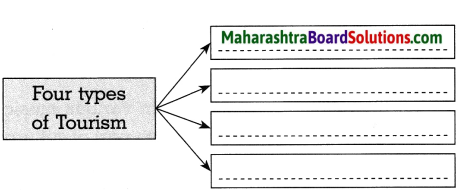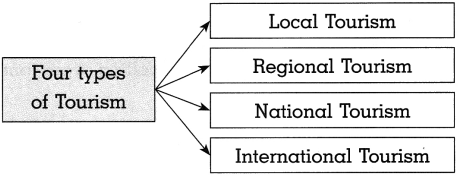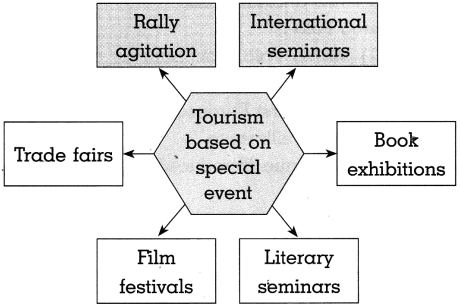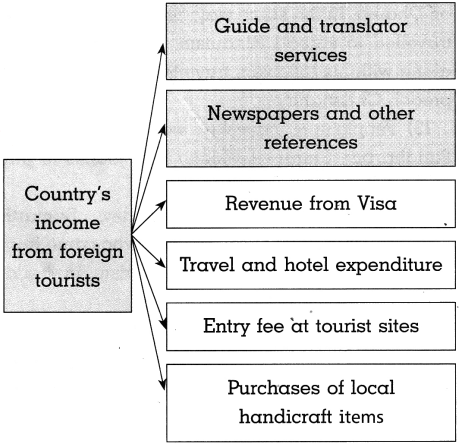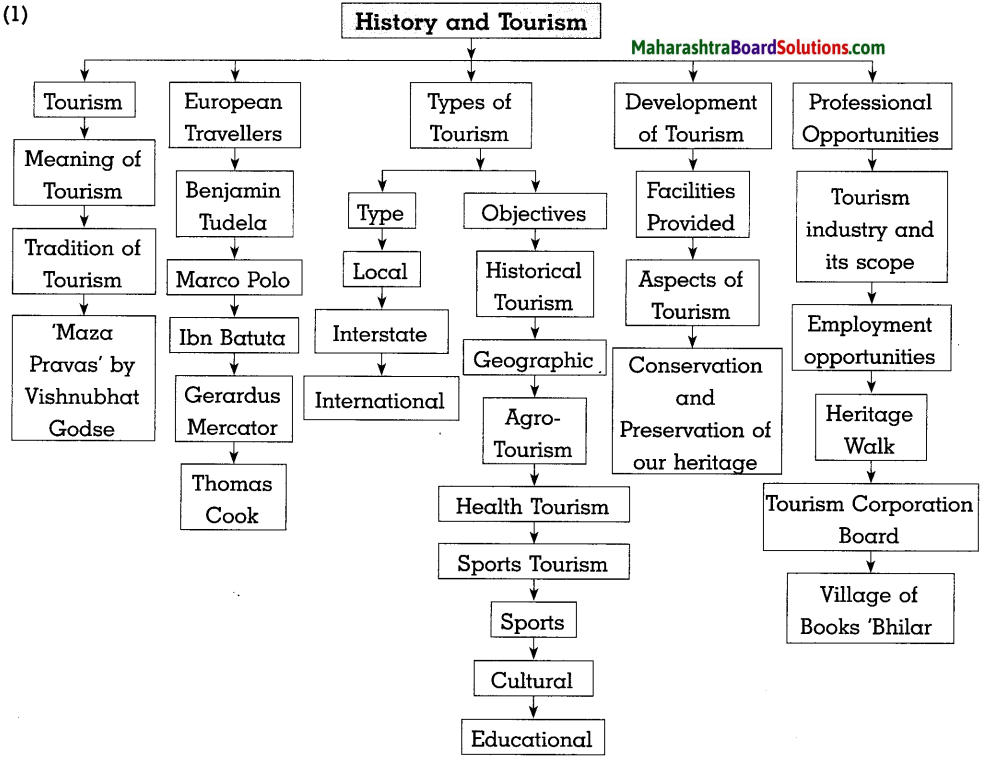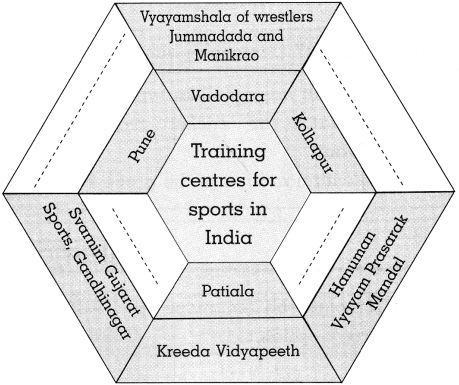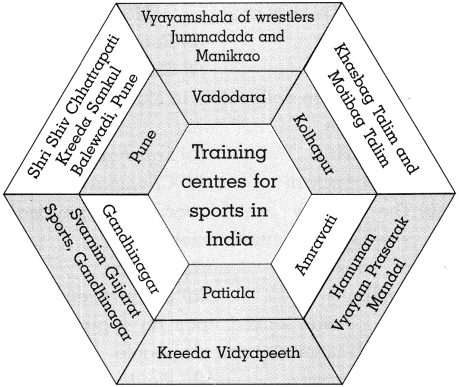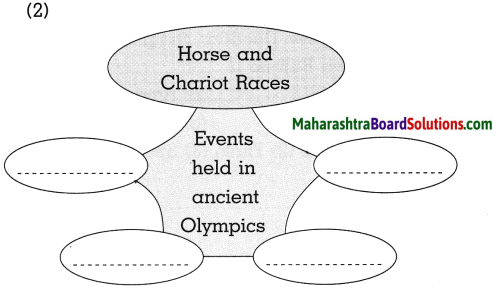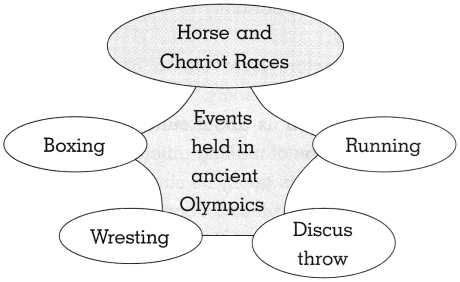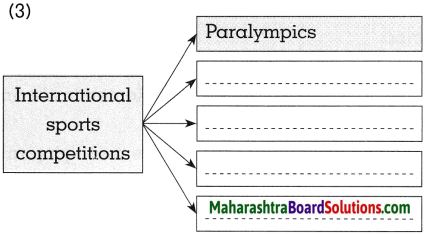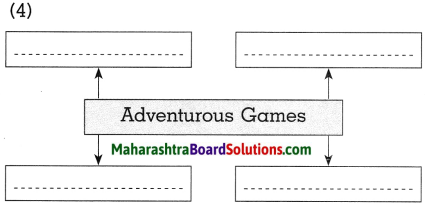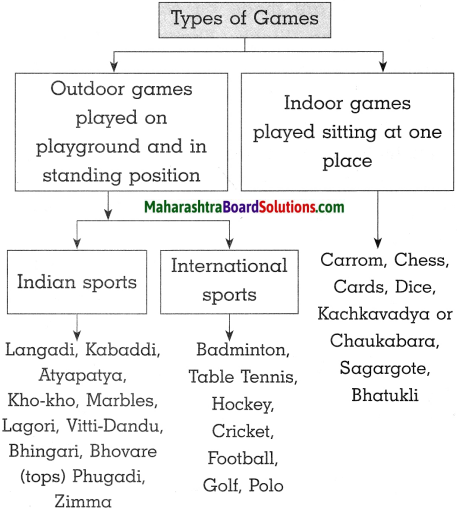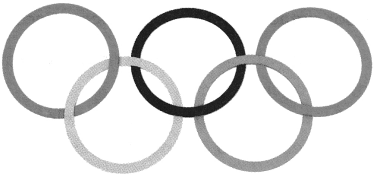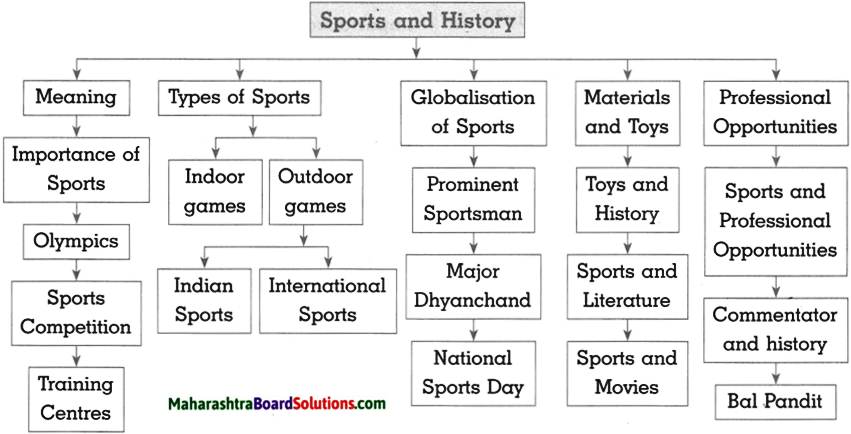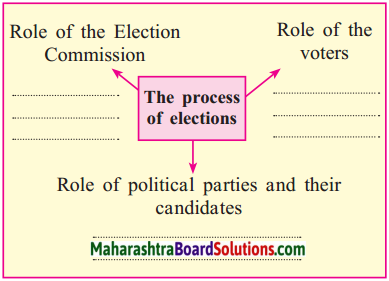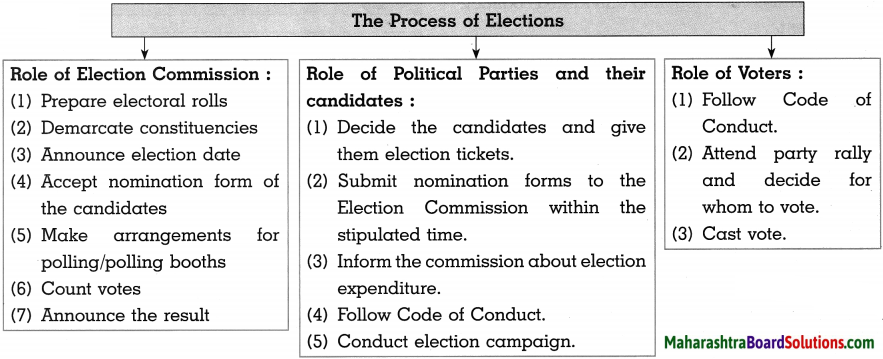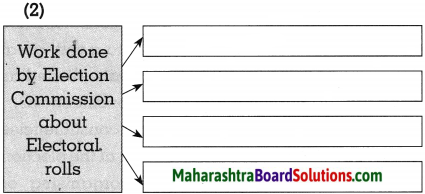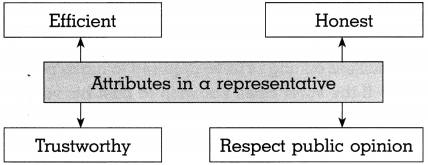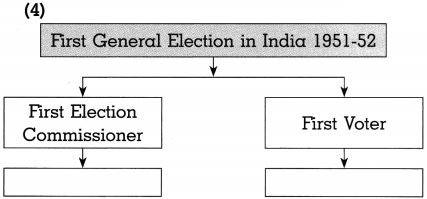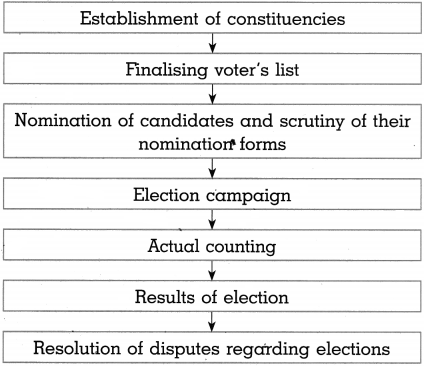Balbharti Maharashtra State Board Class 10 Marathi Solutions Aksharbharati Chapter 8 ऊर्जाशक्तीचा जागर Notes, Textbook Exercise Important Questions and Answers.
Class 10th Marathi Aksharbharati Chapter 8 ऊर्जाशक्तीचा जागर Question Answer Maharashtra Board
Std 10 Marathi Chapter 8 Question Answer
Marathi Aksharbharati Std 10 Digest Chapter 8 ऊर्जाशक्तीचा जागर Textbook Questions and Answers
प्रश्न 1.
खालील तक्त्यात माहिती भरून तो पूर्ण करा.

उत्तरः
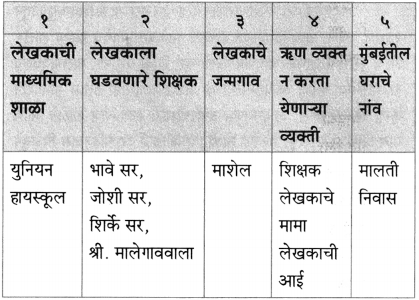
प्रश्न 2.
आकृती पूर्ण करा.
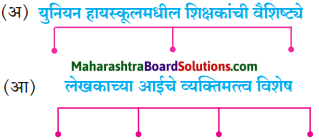
उत्तरः

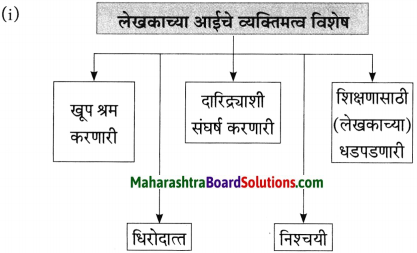
![]()
प्रश्न 3.
कारणे लिहा.
(अ) लेखकाला शिक्षणाबद्दल आंतरिक ओढ निर्माण झाली, कारण ………………………….
उत्तरः
लेखकाला चाचणी परीक्षेची उत्तरपत्रिका घरूनच न्यावी लागे कारण लेखकाची शाळा गरीब होती. फक्त तीन पैसे किंमत असलेली उत्तरपत्रिका शाळा विदयार्थ्यांना देऊ शकत नव्हती.
(आ) लेखकाच्या आईला काँग्रेस हाऊसमध्ये काम मिळाले नाही, कारण ………………………….
उत्तरः
लेखकाच्या आईला काँग्रेस हाऊसमध्ये काम मिळाले नाही कारण तिथे फक्त तिसरी किंवा त्यापेक्षा अधिक शिकलेल्यांनाच काम दिलं जाई.
(इ) लेखकाला गिरगावातील नामांकित शाळांमध्ये प्रवेश मिळाला नाही, कारण ………………………….
उत्तर:
लेखकाला गिरगांवातील नामांकित शाळांमध्ये प्रवेश मिळाला नाही कारण प्रवेश फी ची व्यवस्था होईपर्यंत त्या शाळांमधले प्रवेश बंद झाले होते.
प्रश्न 4.
कंसातील शब्दाला योग्य विभक्ती प्रत्यय लावून रिकाम्या जागेत भरा.
(अ) आपण सगळ्यांनी …………………………. मदत केली पाहिजे. (आई)
उत्तर:
आपण सगळ्यांनी आईला मदत केली पाहिजे.
(आ) आमच्या बाईंनी प्रमुख …………………………. आभार मानले. (पाहुणे)
उत्तर:
आमच्या बाईंनी प्रमुख पाहुण्यांचे आभार मानले.
(इ) शिक्षण पूर्ण झाल्यावर मोहन सरकारी …………………………. रुजू झाला. (नोकरी)
उत्तर:
शिक्षण पूर्ण झाल्यावर मोहन सरकारी नोकरीत रुजू झाला.
![]()
प्रश्न 5.
‘पुसटशा आठवणी माझ्या मनात अधूनमधून वाऱ्याच्या लहरीसारख्या येत असतात.’
प्रस्तुत वाक्यातील अलंकार
(१)
(१) उपमेय
(२) उपमान
प्रश्न 6.
स्वमत.
(अ) ‘भावे सरांचे शब्द हीच खरी माशेलकरांची ऊर्जा’, या विधानाचा तुम्हांला समजलेला अर्थ लिहा.
उत्तरः
भिंगाच्या साहाय्याने सूर्यकिरणांची शक्ती कागदावर एकत्र केल्यास कागद जळतो, हा प्रयोग दाखवून भावे सर लेखकाला म्हणाले ‘माशेलकर तुमची उर्जा एकत्र करा. काहीही जाळता येतं.’ – याचाच अर्थ असा की ज्या विषयाचा ध्यास घेतला आहे, त्यात पूर्णपणे स्वत:ला झोकून दया, कोणतीही गोष्ट तुम्ही मिळवू शकता. साध्य करू शकता. खरोखरच आयुष्याचं फार मोठं तत्त्वज्ञान लेखकाला भावे सरांच्या शिकवणुकीतून मिळालं. त्यांना एकाग्रतेचा मंत्र मिळाला आणि विज्ञान समजलं. भावे सरांच्या शब्दांतून त्यांना पुढे जाण्याची, प्रगती करण्याची जबरदस्त ऊर्जा मिळाली.
(आ) शालेय विद्यार्थ्याच्या भूमिकेतील डॉ. माशेलकर यांचे तुम्हांला जाणवलेले गुणविशेष सोदाहरण लिहा
उत्तरः
वयाच्या सहाव्या वर्षीच लेखकांचे वडील वारल्यामुळे त्यांना व त्यांच्या आईला गिरगावातल्या खेतवाडीतील देशमुख गल्लीमध्ये ‘मालती निवासा’ तील पहिल्या माळ्यावर छोट्याशा खोलीमध्ये रहावे लागले. तेव्हा त्यांची आर्थिक परिस्थिती पूर्णपणे खालावलेली असताना. दारिद्र्याशी संघर्ष करणारी अल्पशिक्षित आईबरोबर शिक्षणाची आस असलेल्या लेखकांना रहावे लागले. यावरून परिस्थितीशी मिळते जुळते घेत आलेल्या संकटांशी सामना करणे हा गुण त्यांच्यातून दिसून येतो. महापालिकेच्या खेतवाडीतील शाळेत वयाच्या बारा वर्षांपर्यंत शिक्षण घेत असताना त्यांना पायात चप्पलही घालायला मिळाली नाही. अशा परिस्थितीत ते शाळा शिकले. यावरून शिक्षणाविषयीची त्यांची चिकाटी, आस्था या गुणांचे दर्शन घडते.
शालेय शिक्षण पूर्ण केल्यावर हायस्कूलची प्रवेश फी एकवीस रुपये होती तेवढेही रुपये त्यावेळी त्यांच्याकडे नव्हते. प्रवेश फी नसल्याने आईच्या ओळखीच्या बाई (माऊली) मदतीला धावून आली पण तोपर्यंत प्रवेश प्रक्रिया बंद झाली होती. शेवटी कसाबसा युनियन हायस्कूल मध्ये प्रवेश मिळताच लेखकांचा पुढील प्रवास सुरु झाला. छोटाशा खोलीत पूरक वातावरण नसताना लेखकांनी आपले शिक्षण थांबवले नाही, तर अशाही वातावरणात त्यांच्या जिद्दीची दाद दयावीशी वाटते. ते पुढे मिळते जुळते घेत शिकतच राहिले.
त्याचवेळी लेखकांच्या हळव्या मनावर त्यांच्या शिक्षकांच्या शिकवण्याचा जो परिणाम झाला त्यामुळे त्याच्या अभ्यासाचा पाया पक्का झाला. शिक्षणाबददल त्यांना अजून ओढ वाटू लागली.
शिक्षणाशिवाय या जगात तरणोपाय नाही हे कळल्यामुळे त्यांच्या आईने त्यांना वाटेल त्या परिस्थितीत शिकवण्याचे ठरवले. कोरे, पाठकोरे, लिहून उरलेले कागद ती एकत्र जमवायची आणि त्यांच्या वह्या करायची. अखंड पेन्सिल न मिळाल्यामुळे जेमतेम हातात धरता येईल अशा पेन्सिलनेच लिहित गेले. एके दिवशी त्यांच्या शिक्षकांनी भिंगाच्या सहाय्यानं सूर्यकिरणांची शक्ती कागदावर एकत्र केल्यास कागद जळतो हे प्रयोगाने सिदध करून दाखवले व माशेलकरांना त्यांच्यातील उर्जाशक्तीचे रुप ओळखण्यास प्रवृत्त केले. त्यावरून त्यांना एकाग्रतेचा मंत्र मिळाला आणि दुसरीकडे विज्ञान समजलं.
या सर्व प्रसंगांतून लेखकाचा आत्मविश्वास वाढवून दिला. जगण्याचे भान मिळाले. आणि पुढे लेखक फार मोठे वैज्ञानिक संशोधक झाले.
![]()
(इ) डॉ. माशेलकर यांची मातृभक्ती ज्या प्रसंगातून ठळकपणे जाणवते, ते प्रसंग पाठाधारे लिहा.
उत्तरः
स्वतःचे वडील वारल्यावर आई त्यांना घेऊन मुंबईस खेतवाडीतील देशमुख गल्लीत एका छोट्यासा पहिल्या माळ्यांवर राहिली तरीही लेखकांनी आईस कधी नाही म्हटले नाही. त्याही स्थितीत ते आईबरोबर राहिले.
हायस्कूलला शिकण्यास गेल्यावर एकवीस रूपये फी पुढील कॉलेजसाठी प्रवेश मिळवण्यासाठी नव्हती तरीही धीर न सोडता आजूबाजूच्या बिहाडांतील काही कामे करून तिने प्रवेश फीची व्यवस्था केली व प्रवेश घेतला. मात्र अशा वातावरणात लेखकांनी जिद्दीने अभ्यास केला.
उत्तरपत्रिकेची फी भरण्यासाठीचे फक्त तीन पैसे एवढेही पैसे त्यांच्याकडे नसल्याने मग आईने गिरगावातील अनेक कामे केली. प्रचंड कष्ट केले. पडेल ते काम केले. हे पाहून लेखकांच्या मनातील जिद्द अजून वाढली व ते अति जोमाने शिक्षण घेऊ लागले. इत्यादी उदाहरणांतून माशेलकरांची मातृभक्ती ठळकपणे दिसून येते.
(ई) ‘माझ्या जीवनातील शिक्षकाचे स्थान’, या विषयावर तुमचे विचार लिहा.
उत्तर:
प्रत्येकाच्या जीवनात आपल्या शिक्षकांचे स्थान फार महत्त्वपूर्ण असते. माझ्याही जीवनात शिक्षकांचे स्थान फार मोठे आहे. त्यांनी केलेल्या संस्कारांमुळे जीवनाला योग्य दिशा मिळाली, आत्मविश्वासाने पुढे जाण्याची शक्ती मिळाली. मी आज ज्या मोठ्या पदावर पोहोचलो आहे ते केवळ माझ्या शिक्षकांच्या मार्गदर्शनामुळेच, म्हणून माझ्या जीवनात माझ्या शिक्षकांचे स्थान फार मोठे आहे.
Marathi Akshar Bharati Class 10 Textbook Solutions Chapter 8 ऊर्जाशक्तीचा जागर Additional Important Questions and Answers
प्रश्न १. पुढील उताऱ्याच्या आधारे दिलेल्या सूचनेनुसार कृती करा.
कृती १: आकलन कृती
प्रश्न 1.
आकृतिबंध पूर्ण करा,
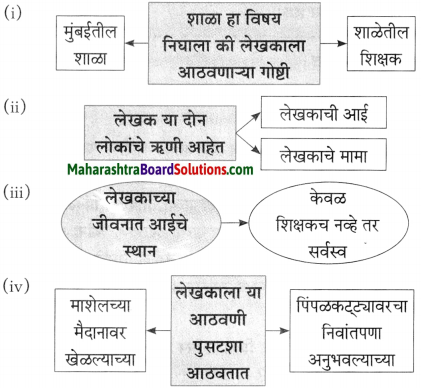
![]()
प्रश्न 2.
ओघ तक्ता पूर्ण करा.
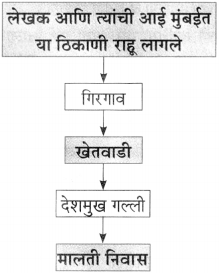
प्रश्न 3.
योग्य पर्याय शोधून रिकाम्या जागा भरा.
(i) ……………………….. हीच प्रत्येक मुलाची पहिली शिक्षक असते. (ताई, माई, आई, बाई)
उत्तर:
(i) आई
(ii) आमचे मूळ गाव ……………………….. गोव्यातील माशेल. (उत्तर, पूर्व, पश्चिम, दक्षिण)
उत्तर:
(ii) दक्षिण
(iii) मी आणि माझी आई ……………………….. येऊन पोहोचलो. (गोव्यात, अमरावतीत, मुंबईत, पुण्यात)
उत्तर:
(iii) मुंबईत
कृती २ : आकलन कृती
प्रश्न 1.
उत्तरे लिहा.
प्रश्न 2.
कोण ते लिहा.
(i) दारिद्र्याशी संषर्घ करणारी – लेखकाची आई
(ii) शाळेत कसा जाऊ? असे प्रश्नचिन्ह घेऊन वावरणारे – लेखक माशेलकर
प्रश्न 3.
घटना आणि परिणाम लिहा.
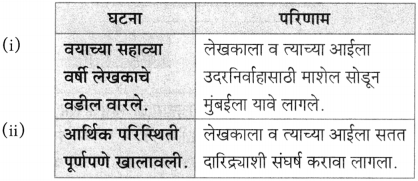
![]()
प्रश्न 4.
एका वाक्यात उत्तरे लिहा.
(i) लेखकाच्या गिरगावातल्या शाळेचे नाव काय होते?
उत्तरः
लेखकाच्या गिरगावातल्या शाळेचे नाव ‘युनियन हायस्कूल’ असे होते.
(ii) लेखक आपल्या आईचे व मामाचे ऋण का मानतात?
उत्तरः
युनियन हायस्कुल व त्यांच्यावर संस्कार करणाऱ्या शिक्षकांशी संपर्क यांच्यामुळे आला म्हणून लेखक आईचे व मामाचे ऋण मानतात.
(iii) लेखकाच्या बाबतीत त्यांचे सर्वस्व कोण होते?
उत्तर:
लेखकाच्या बाबतीत त्यांचे सर्वस्व आई होती.
(iv) उदहनिर्वाहासाठी लेखक आणि त्यांच्या आईला कुठे जावे लागले?
उत्तरः
उदरनिर्वाहासाठी लेखक आणि त्यांच्या आईला मुंबईला जावे लागले.
प्रश्न 5.
जोड्या जुळवा.

उत्तर:
(i – आ),
(ii – ई),
(iii – अ),
(iv – इ)
प्रश्न 6.
उताऱ्यानुसार वाक्यांचा क्रम लावा.
(i) मी आणि माझी आई मुंबईत येऊन पोहोचलो.
(ii) माझे बालपण तिथेच गेले.
(iii) माझ्या वयाच्या सहाव्या वर्षी माझे वडील वारले.
(iv) आम्हांला उदरनिर्वाहासाठी आमचे माशेल हे गाव सोडावे लागले.
उत्तर:
(i) माझे बालपण तिथेच गेले.
(ii) माझ्या वयाच्या सहाव्या वर्षी माझे वडील वारले.
(iii) आम्हांला उदरनिर्वाहासाठी आमचे माशेल हे गाव सोडावे लागले.
(iv) मी आणि माझी आई मुंबईत येऊन पोहोचलो.
![]()
प्रश्न 7.
आकृतिबंध पूर्ण करा.
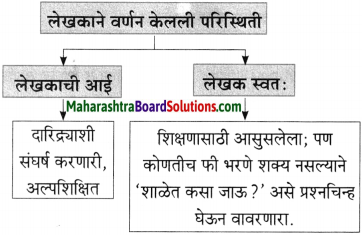
कृती ३ : स्वमत
प्रश्न 1.
लेखकाच्या बालपणीच्या काळाचं वर्णन तुमच्या शब्दांत लिहा.
उत्तरः
लेखकाचे बालपण गोव्यातील माशेल या गावी गेले. आई, वडील आणि त्यांचे मामाही याच गावात राहात होते. माशेलच्या मैदानावर खेळल्याच्या, तिथल्या पिंपळकट्ट्यावर बसून निवांतपणा अनुभवल्याच्या आठवणी त्यांना आठवतात. वयाच्या सहाव्या वर्षी त्यांचे वडील वारले. त्यामुळे पोट भरण्यासाठी त्यांना व त्यांच्या आईला माशेल सोडून मुंबईला यावे लागले.
प्रश्न 2.
आपल्या शालेय शिक्षणातील अडचणींचे वर्णन लेखकाने कसे केले आहे?
उत्तरः
वयाच्या ६व्या वर्षी लेखकाचे वडील वारले म्हणून त्यांच्या आईला व त्यांना माशेल सोडून मुंबईला यावे लागले. त्यांची आर्थिक परिस्थिती पूर्ण खालावलेली होती. शिक्षण घेण्यासाठी लेखक खूप उत्सुक होते. पण फी भरणे शक्य नसल्यामुळे आपण शाळेत जाऊ शकू की, नाही असे त्यांना वाटत असे.
प्रश्न 3.
माशेलहून मुंबईला आल्यावर लेखकाची व त्याच्या आईची स्थिती कशी होती ते थोडक्यात लिहा.
उत्तरः
वडिलांच्या निधनामुळे लेखक व त्यांची आई उदरनिर्वाहासाठी मुंबईला आले. त्यांची आर्थिक परिस्थिती पूर्णपणे खालावलेली होती. गिरगावातल्या खेतवाडीतील देशमुख गल्लीमध्ये मालती निवासातील पहिल्या माळ्यावर छोट्याशा खोलीत ते राहत होते. लेखकाच्या आईकडे उदरनिर्वाहाचे कोणतेच साधन नसल्यामुळे तिला व लेखकाला खूप गरिबीत दिवस काढावे लागले. शाळेची फी भरणेही त्यांच्या आईला शक्य नव्हते.
प्रश्न 4.
लेखकाची शाळा व शिक्षक यांच्याबद्दल माहिती तुमच्या शब्दात लिहा.
उत्तरः
लेखक सहा वर्षाचे असतानाच त्यांचे वडील वारले म्हणून त्यांच्या आईला व त्यांना मुंबईला यावे लागले. त्यांच्या मामांच्या प्रयत्नांनी व आईच्या कष्टाळूवृत्तीमुळे त्यांचे शिक्षण सुरू झाले. गिरगावातल्या युनियन हायस्कूलमध्ये त्यांना प्रवेश मिळाला. या शाळेतील सर्वच शिक्षक अत्यंत प्रेमळ व आपुलकीनं संस्कार करणारे होते आणि त्यांच्या मार्गदर्शनामुळे लेखकाच्या जीवनाला योग्य ती दिशा मिळाली.
प्रश्न २. पुढील उताऱ्याच्या आधारे दिलेल्या सूचनेनुसार कृती करा.
कृती १ : आकलन कृती
प्रश्न 1.
कारणे लिहा.
(i) माशेलहून लेखकाचे मामा मुंबईला आले कारण . . .
उत्तर:
माशेलहून लेखकाचे मामा मुंबईला आले कारण त्यांना लेखकाच्या शिक्षणाची सोय करायची होती.
![]()
(ii) वयाच्या बाराव्या वर्षापर्यंत लेखकाला अनवाणीच राहावे लागले कारण . . .
उत्तरः
वयाच्या बाराव्या वर्षापर्यंत लेखकाला अनवाणीच राहावे लागले कारण लेखकाच्या आईची आर्थिक परिस्थिती अत्यंत खालावलेली होती त्यामुळे ती लेखकासाठी चप्पल खरेदी करू शकत नव्हती.
प्रश्न 2.
आकृतिबंध पूर्ण करा.
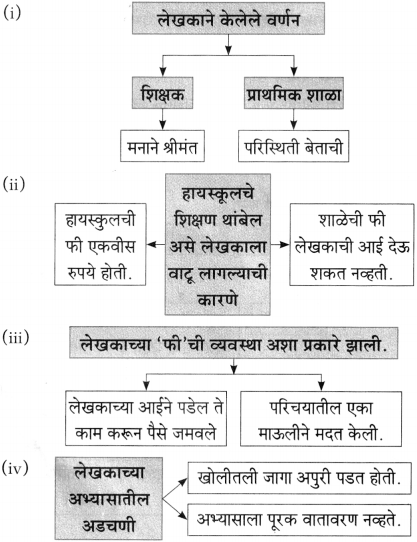
प्रश्न 3.
एका वाक्यात उत्तरे लिहा.
(i) कोणामुळे लेखकाला खेतवाडीतील प्राथमिक शाळेत प्रवेश मिळू शकला?
उत्तर:
लेखकाच्या मामांमुळे त्यांना खेतवाडीतील प्राथमिक शाळेत प्रवेश मिळू शकला.
(ii) लेखकाच्या हायस्कूलची प्रवेश फी किती रुपये होती?
उत्तरः
लेखकाच्या हायस्कूलची प्रवेश फी एकवीस रुपये होती.
(iii) लेखकाच्या आईने कशाप्रकारे पैसे जमवण्यास सुरुवात केली?
उत्तरः
लेखकाच्या आईने आजूबाजूच्या बिहाडांतील काही कामे करून पैसे जमवण्यास सुरुवात केली.
![]()
प्रश्न 4.
योग्य पर्याय निवडून रिकाम्या जागा भरा,
(i) माझ्याप्रमाणेच शाळेचीही परिस्थिती …………………………… होती. (चांगली, गुणवत्तापूर्वक, बेताचीच, हालाखीची)
(ii) पण तोपर्यंत …………………………… त्यावेळच्या नामांकित शाळांमधले प्रवेश बंद झाले होते. (गोरेगावातील, मुंबईतील, गिरगावातील, गोव्यातील)
(iii) अखेर …………………………… हायस्कूलमध्ये मला प्रवेश मिळाला. (युनिटी, युनियन, न्यू इंग्लिश)
उत्तर:
(i) बेताचीच
(ii) गिरगावातील
(iii) युनियन
कृती २ : आकलन कृती
प्रश्न 1.
आकृतिबंध पूर्ण करा.
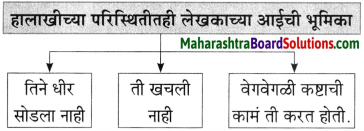
प्रश्न 2.
कोण ते लिहा.
(i) माशेलहून मुंबईला आलेले. – [लेखकाचे मामा]
(ii) यांना युनियन हायस्कूलमध्ये प्रवेश मिळाला – [लेखकाला]
(iii) मनानं श्रीमंत असलेले – [लेखकाचे शिक्षक]
प्रश्न 3.
उताऱ्यानुसार वाक्यांचा क्रम लावा.
(i) तिच्या परिचयातील एक माऊली मदतीला धावली.
(ii) माध्यमिक शिक्षणाचा पुढील टप्पा सुरू झाला.
(iii) माशेलहून मुंबईत आलेले माझे मामाही मदतीला आले.
(iv) वयाच्या बाराव्या वर्षापर्यंत मला अनवाणीच राहावं लागलं.
उत्तर:
(i) माशेलहून मुंबईत आलेले माझे मामाही मदतीला आले.
(ii) वयाच्या बाराव्या वर्षापर्यंत मला अनवाणीच राहावं लागलं.
(iii) तिच्या परिचयातील एक माऊली मदतीला धावली.
(iv) माध्यमिक शिक्षणाचा पुढील टप्पा सुरू झाला.
प्रश्न 4.
जोड्या जुळवा.

उत्तर:
(i – इ),
(ii – ई),
(iii – आ),
(iv – अ)
![]()
प्रश्न 5.
सहसंबंध लिहा.
(i) प्राथमिक : शाळा :: माध्यमिक : ……………………..
(ii) अपूरी : जागा :: पूरक : ……………………..
उत्तर:
(i) शिक्षण
(ii) वातावरण
प्रश्न 6.
आकृतिबंध पूर्ण करा.
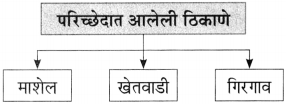
कृती ३ : स्वमत
प्रश्न 1.
‘पण त्याही परिस्थितीत मी जिद्दीने अभ्यास करत राहिलो’ हे विधान तुमच्या शब्दांत स्पष्ट करा.
उत्तरः
शालेय शिक्षण पूर्ण झाल्यानंतर हायस्कूल शिक्षणाच्या वेळी लेखकांसमोर अनेक अडचणी निर्माण झाल्या. अनवाणी शाळेत गेले. छोट्याशा खोलीतली जागा अपुरी पडत होती. अभ्यासाला पूरक वातावरण नव्हते. अनेक अडीअडचणी आणि अभाव सहन करून लेखक जिद्दीने अभ्यास करत राहिले आणि परीक्षेत चांगले यश मिळवले.
प्रश्न 2.
लेखकाच्या आईचे वर्णन उताऱ्याच्या आधारे तुमच्या शब्दांत लिहा.
उत्तरः
पतीच्या निधनामुळे आर्थिक परिस्थिती पूर्णपणे खालावलेल्या स्थितीत ती आपल्या मुलाला घेऊन मुंबईला आली. विपरीत परिस्थितीतही तिने धीर सोडला नाही. मिळेल ते, पडेल ते काम तिने केले. पण आपल्या मुलाच्या शिक्षणासाठी ती खंबीरपणे त्याच्या पाठी उभी राहिली. परिस्थितीला शरण न जाता धीराने वागणारी अत्यंत कष्टाळू अशी लेखकाची आई होती.
प्रश्न 3.
लेखकाला युनियन हायस्कूलमध्ये कशाप्रकारे प्रवेश मिळाला?
उत्तरः
लेखकाच्या हायस्कूल प्रवेशाच्या वेळी लेखकाच्या आईची आर्थिक परिस्थिती अत्यंत बिकट होती. पण लेखकाच्या आईने पडेल ते काम केले आणि एका सहृदय मातेने मदत केली. अशा प्रकारे २१ रुपये फी जमवली. तो पर्यंत सर्व चांगल्या शाळांमधले प्रवेश बंद झाले होते. म्हणून मग त्यांनी युनियन हायस्कूलमध्ये प्रवेश घेतला. याच युनियन हायस्कूलमधील शिक्षक, त्यांचे संस्कार, तेथील शिक्षण यामुळे जीवनातल्या अनेक प्रगतीच्या वाटा लेखकासमोर निर्माण झाल्या.
प्रश्न ३. पुढील उताऱ्याच्या आधारे दिलेल्या सूचनेनुसार कृती करा.
कृती १ : आकलन कृती
प्रश्न 1.
आकृतिबंध पुर्ण करा.
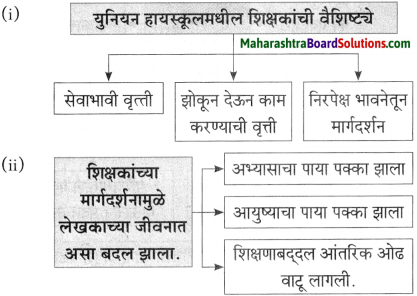
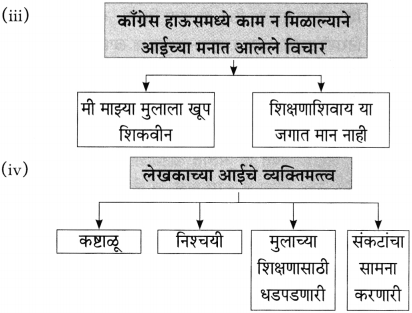
![]()
प्रश्न 2.
रिकाम्या जागा भरा.
(i) ……………………….. एक आंतरिक ओढ वाटू लागली. (शिक्षणाबद्दल, खेळाबद्दल, कलेबद्दल, शाळेबद्दल)
(ii) त्यावेळी उत्तरपत्रिकेची किंमत फक्त ……………………….. पैसे असायची. (एक, दोन, तीन, चार)
(iii) अखंड ……………………….. मला मिळणं अवघड होतं. (पेन्सिल, पेन, वही, फळा)
उत्तर:
(i) शिक्षणाबद्दल
(ii) तीन
(iii) पेन्सिल
प्रश्न 3.
जोड्या जुळवा.
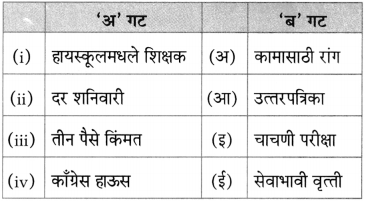
उत्तर:
(i – ई),
(ii – इ),
(iii – आ),
(iv – अ)
कृती २ : आकलन कृती
प्रश्न 1.
आकृतिबंध पूर्ण करा.
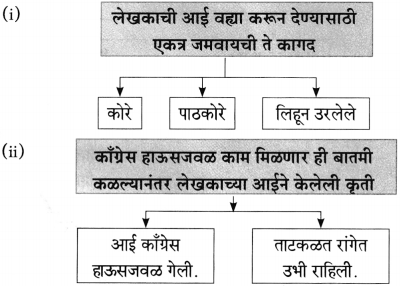
प्रश्न 2.
कारणे लिहा.
(i) जेमतेम हातात धरता येईल अशा पेन्सिलीन लेखकाला लिहावं लागे कारण . . . . .
उत्तर:
जेमतेम हातात धरता येईल अशा पेन्सिलीनं लेखकाला लिहावं लागे कारण अखंड पेन्सिल विकत घेण्याएवढे पैसे लेखकाच्या आईकडे नव्हते.
![]()
प्रश्न 3.
एका वाक्यात उत्तरे लिहा.
(i) लेखकाची आई काँग्रेस हाऊसजवळ का गेली?
उत्तर:
तिथे काही काम मिळणार आहे, अशी बातमी कळाल्याने लेखकाची आई काँग्रेस हाऊसजवळ गेली.
(ii) लेखकाच्या आईने लेखकासाठी कशाप्रकारे वह्या बनवल्या?
उत्तर:
कोरे, पाठकोरे, लिहून उरलेले कागद एकत्र जमा करून लेखकाच्या आईने लेखकासाठी वह्या बनवल्या.
(iii) लेखकाच्या हायस्कूलमध्ये नेहमी कोणत्या दिवशी चाचणी परीक्षा घेण्यात येत असे?
उत्तरः
लेखकाच्या हायस्कूलमध्ये दर शनिवारी चाचणी परीक्षा घेण्यात येत असे.
(iv) काँग्रेस हाऊसजवळ काम न मिळाल्याने लेखकाच्या आईने काय ठरविले?
उत्तर:
काँग्रेस हाऊसजवळ काम न मिळाल्याने आपल्या मुलाला म्हणजेच लेखकाला खूप शिकवेन, असे त्यांच्या आईने ठरवले.
प्रश्न 4.
उताऱ्यानुसार घटनांचा क्रम लावा.
(i) तिनं ठरवलं, की मी माझ्या मुलाला खूप शिकवीन.
(ii) रांगेत उभी राहिली, तशीच ताटकळत.
(iii) ती नाराज झाली, घराकडं मागं फिरली.
(iv) काँग्रेस हाऊसजवळ काही काम मिळणार आहे, असं समजल्यानं एकदा ती तिकडं गेली.
उत्तर:
(i) काँग्रेस हाऊसजवळ काही काम मिळणार आहे, असं समजल्यानं एकदा ती तिकडं गेली.
(ii) रांगेत उभी राहिली, तशीच ताटकळत.
(iii) ती नाराज झाली, घराकडं मागं फिरली.
(iv) तिनं ठरवलं, की ‘मी माझ्या मुलाला खूप शिकवीन,
प्रश्न 5.
सहसंबंध लिहा.
(i) सेवाभावी : वृत्ती :: प्रचंड : …………………………….
(ii) अंगावर : काटा :: डोळ्यांत : …………………………….
उत्तर:
(i) कष्ट
(ii) पाणी
![]()
कृती ३: स्वमत
प्रश्न 1.
युनियन हायस्कूलमधील शिक्षकांबद्दल लेखकाने सांगितलेल्या आठवणी तुमच्या शब्दांत लिहा.
उत्तरः
युनियन हायस्कूलमधले सगळे शिक्षक खूप प्रेमळ होते. त्यांची वृत्ती सेवाभावी होती. विदयार्थ्यांना शिकवताना ते स्वत:ला झोकून देत असत. लेखकाच्या शालेय जीवनात त्यांनी अगदी निरपेक्ष भावनेने मार्गदर्शन केले. यामुळे लेखकाच्या शालेय अभ्यासाचा पाया पक्का झाला असे नाही तर आयुष्याचा पाया देखील पक्का झाला. त्यामुळेच लेखकाच्या मनात शिक्षणाबद्दल आंतरिक ओढ निर्माण झाली.
प्रश्न 2.
लेखकाच्या आईला काँग्रेस हाऊसजवळ काम मिळाले नाही याचे वर्णन तुमच्या शब्दांत लिहा.
उत्तर:
लेखकाच्या शाळेत दर शनिवारी चाचणी परीक्षा असायची उत्तरपत्रिका घरून आणावी लागे. तिची किंमत तीन पैसे असायची पैशाची व्यवस्था करण्यासाठी ती काँग्रेस हाऊसजवळ काम मिळेल या आशेने खूप वेळ रांगेत ताटकळत उभी राहिली. त्यानंतर तिला कळले की, तिसरी किंवा त्यापेक्षा जास्त शिकलेल्यांनाच या ठिकाणी काम मिळतं. त्यामुळे तिची खूप निराशा झाली. तेव्हाच आपल्या मुलाला खूप शिकवायचं असा निश्चय तिने केला.
प्रश्न 3.
लेखकाच्या शिक्षणासाठी लेखकाच्या आईने कोणते कष्ट सोसले ते लिहा.
उत्तरः
लेखकासोबत ती अत्यंत छोट्याशा घरात राहिली. प्रचंड कष्ट केले. पडेल ते काम केले. व लेखकाच्या शिक्षणासाठी पैसे जमवले. कोरे,पाठकोरे कागद जमवून ती लेखकासाठी वह्या तयार करायची. छोट्या-छोट्या का होईना त्या पेन्सिली ती लेखकाला लिहायला यायची. कोणत्याही परिस्थितीत लेखकाच्या शिक्षणात खंड पडू नये यासाठी ती सतत प्रयत्नशील असायची.
प्रश्न 4.
आपल्या आईबद्दलच्या लेखकाच्या भावना तुमच्या शब्दांत लिहा.
उत्तरः
लेखक म्हणतात माझ्या आईच्या श्रमाला, कष्टाला तोड नाही. तिच्या श्रमाचं वर्णन करताना ते भावूक होऊन म्हणतात की, माझ्या आईचे श्रम आठवले की, माझ्या डोळ्यात अश्रू उभे राहतात. अशा या प्रचंड कष्ट करणाऱ्या आईचे लेखक सदैव ऋण मानतात. तिला ते आपली पहिली शिक्षक व सर्वस्व मानतात. प्रश्न ४. पुढील उताऱ्याच्या आधारे दिलेल्या सूचनेनुसार कृती करा,
कृती १ : आकलन कृती
प्रश्न 1.
पुढील कृती करा.
(i) ‘भौतिक शास्त्र’ असे उत्तर येईल असा प्रश्न तयार करा?
उत्तरः
भावे सर कोणता विषय शिकवत असतं?
(ii) विषयाची गोडी लावली, असे उत्तर येईल असा प्रश्न तयार करा.
उत्तर:
विज्ञान शिकवताना भावे सरांनी आणखी कोणती गोष्ट साधली?
![]()
प्रश्न 2.
आकृतिबंध पूर्ण करा.
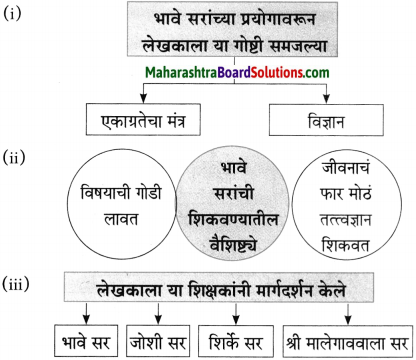

प्रश्न 3.
रिकाम्या जागा भरा.
(i) ……………………………. हा विषय शिकवताना त्यांनी केवळ शास्त्र शिकवलं नाही, तर त्या विषयाची गोडी लावली. (भूगोलातील, मराठीतील, इंग्रजीतील, विज्ञानातील)
(ii) भिंगाच्या साहाय्यानं ……………………………. शक्ती कागदावर एकत्र केल्यास कागद जळतो. (चंद्रकिरणांची, ऊर्जेची, सूर्यकिरणांची, विजेची)
(iii) माझी शाळा हे ‘माझे ……………………………. केंद्र’ डोळ्यांसमोर उभे राहते. (संस्कार, स्मरणीय, आवडते, संस्कारक्षम)
उत्तर:
(i) विज्ञानातील
(ii) सूर्यकिरणांची
(iii) संस्कार
प्रश्न 4.
जोड्या जुळवा.
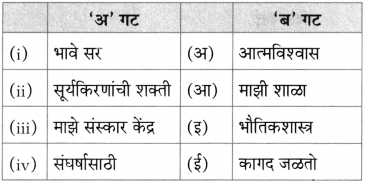
उत्तर:
(i – इ),
(ii – ई),
(iii – आ),
(iv – अ)
कृती २ : आकलनकृती
प्रश्न 1.
कोण ते लिहा.
(i) लेखकाला जीवनाचे तत्त्वज्ञान देणारे – [भावे सर]
(ii) पुन्हा मनोमनी शाळेत जाणारे – [लेखक]
प्रश्न 2.
आकृतिबंध पूर्ण करा,
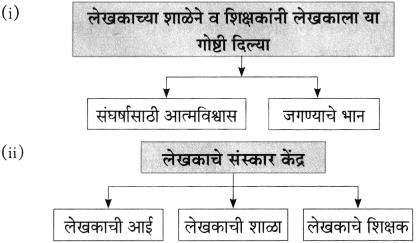
![]()
प्रश्न 3.
एका वाक्यात उत्तरे लिहा.
(i) लेखकाला भावे सर कोणत्या हायस्कूलमध्ये भेटले?
उत्तर:
लेखकाला युनियन हायस्कूलमध्ये भावे सर भेटले.
(ii) लेखकाला कोणते क्षण आठवतात?
उत्तरः
प्रचंड दारिद्र्याशी सामना करतानाचे क्षण लेखकाला आठवतात.
(iii) भावे सरांनी कोणता प्रयोग करून दाखवला?
उत्तर:
भावे सरांनी भिंगाच्या साहाय्याने कागद जाळण्याचा प्रयोग करून दाखवला.
(iv) लेखकाला भावे सरांच्या शिकवणुकीतून काय गवसलं?
उत्तरः
लेखकाला भावे सरांच्या शिकवणुकीतून आयुष्याचं फार मोठं तत्त्वज्ञान गवसलं.
प्रश्न 4.
सहसंबंध लिहा.
(i) विषयाची : गोडी :: जगण्याचे : ……………………………..
(ii) एकाग्रतेचा : मंत्र :: संघर्षासाठी : ……………………………..
उत्तर:
(i) भान
(ii) आत्मविश्वास
कृती ३ : स्वमत
प्रश्न 1.
लेखकाने आपल्या शाळेतील शिक्षकांबद्दलच्या भावना कशाप्रकारे व्यक्त केल्या आहेत ते तुमच्या शब्दांत व्यक्त करा.
उत्तरः
लेखक म्हणतात की, माझ्या जीवनाच्या जडणघडणीत माझ्या शिक्षकांचा फार मोठा सहभाग आहे. भावे सरांकडून एकाग्रतेचा मंत्र आणि जीवनाचे तत्वज्ञान मिळाले. जोशी सर शिर्के सर, मालेगाववाला सर यांच्याकडून उत्तम मार्गदर्शन मिळाले. आयुष्याच्या उभारणीसाठी संस्कार आणि संघर्षासाठी सामना करण्याचं बळ मिळालं. जीवनात खंबीरपणे उभे राहण्याचा आत्मविश्वास त्यांच्या सगळ्या शिक्षकांकडून त्यांना मिळाला.
![]()
प्रश्न 2.
लेखकाने संस्कार केंद्र कोणाला म्हटले आहे ? का?
उत्तरः
लेखकाने ‘संस्कार केंद्र’ त्यांची आई, शाळा आणि शिक्षक यांना म्हटले आहे. अत्यंत गरिबीच्या परिस्थितीतही मुलाच्या शिक्षणासाठी कष्ट करणारी आई. परिस्थितीपुढे शरण न जाता जिद्दीने पुढे जाण्याचा मार्ग तिने लेखकाला दाखवला आणि शिक्षकांनी दिलेल्या संस्कारातून, शिकवणुकीतून लेखकाला जीवन जगण्यासाठी आत्मविश्वास मिळाला. या सगळ्यामुळे लेखकाच्या जीवनाला योग्य दिशा मिळाली.
प्रश्न 3.
विदयार्थ्यांच्या व्यक्तिमत्त्वाच्या जडणघडणीत शाळा किती महत्त्वाची भूमिका बजावते यावर तुमचे विचार लिहा.
उत्तरः
विदयार्थी हा बालपणापासून शाळेत असतो त्याचा अधिकाधिक वेळ शाळेत जातो आणि त्या वयात तो जे शिकतो अनुभवतो ते त्याच्या मनावर कायमस्वरूपी परिणाम करते. शाळेतले शिक्षक, उपक्रम, शाळेतले वातावरण, या सगळ्यांचा परिणाम त्याच्यावर होत असतो. बालपणापासून ते किशोरवयापर्यंत अनेक गोष्टीतून तो शिकतो. म्हणून विदयार्थ्यांच्या व्यक्तिमत्वाच्या जडणघडणीत शाळेची फार महत्त्वाची भूमिका असते असे मला वाटते. स्वाध्याय कृती
प्रश्न 4.
कारणे लिहा.
(i) लेखकाला शिक्षणाबद्दल आंतरिक ओढ निर्माण झाली, कारण . . .
उत्तरः
लेखकाला शिक्षणाबद्दल आंतरिक ओढ निर्माण झाली, कारण युनियन हायस्कूलमधील शिक्षकांनी केलेले मार्गदर्शन व दिलेले शिक्षण
ऊर्जाशक्तीचा जागर Summary in Marathi
ऊर्जाशक्तीचा जागर पाठपरिचय
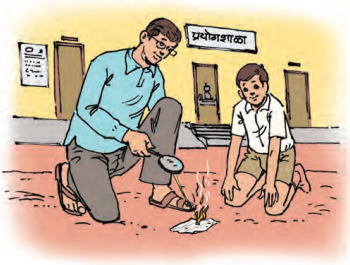
‘उर्जाशक्तीचा जागर’ हा पाठ ’डॉ. रघुनाथ माशेलकर’ यांनी लिहिला आहे. या पाठात त्यांनी आपल्या लहानपणीच्या आठवणी दिलेल्या आहेत. लहानपणीच पित्याचे छत्र हरपलेल्या माशेलकरांना त्यांच्या आईने अत्यंत प्रतिकूल परिस्थितीतून जिद्दीने शिक्षण घेण्यास प्रवृत्त कसे केले, त्याचे चित्रदर्शी वर्णन केले आहे.
ऊर्जाशक्तीचा जागर Summary in English
‘Urjashakticha Jagar’ is written by Dr. Raghunath Mashelkar. He has written about his childhood memories. He lost his father at an early age. Thereafter, the manner in which his mother helped and inspired him to get an education, irrespective of all odds, has been beautifully explained.
ऊर्जाशक्तीचा जागर शब्दार्थ
- मुलभूत – पायाभूत – (basic)
- बौद्धिक – बुद्धिशी संबंधित – (intellectual)
- क्षमता – सामर्थ्य – (ability)
- नियोजन – योजना – (planning)
- शास्त्रज्ञ – वैज्ञानिक – (a scientist)
- तंत्रज्ञान – (technology)
- धोरण उद्दिष्ट – (aim)
- महत्कार्य – महान कार्य – (great work)
- कष्ट – मेहनत – (hard work)
- शिस्त – वळण – (discipline)
- नेतृत्वगुण – (leadership quality)
- संरक्षण – (protection)
- हरपणे – गमावणे – (to lose)
- प्रतिकूल – उलट, विरोधी – (adverse)
- जिद्द – आग्रह – (ambition)
- आपुलकी – आपलेपणा – (affection)
- संस्कार – चांगले गुण – (values)
- ऋण – उपकार – (obligation)
- संपर्क – संबंध – (contact)
- सर्वस्व – सर्व काही – (one’s all)
- पिंपळकट्टा – (raised platform of stones around fig tree)
- निवांतपणा – शांतपणा – (silence)
- पुसट – अस्पष्ट – (faint)
- लहर – वाऱ्याची झुळूक – (a breeze)
- वारले – मृत्यु पावले – (die)
- उदरनिर्वाह – उपजीविका – (livelihood)
- माडी – (a lott)
- आर्थिक परिस्थिती – (financial condition)
- खालावणे – बिघडणे दारिद्रय – गरिबी – (poverty)
- संघर्ष – झुंज – (struggle)
- आसुसणे – तीव्र इच्छा होणे – (to lust)
- अनवाणी – पायात वहाणा व काहीही न घालता – (footed)
- नामांकित – प्रख्यात – (famous)
- टप्पा – मजल – (a stage)
- अपुरी – पुरेशी नसलेली – (insufficient)
- पुरक – योग्य – (suitable)
- सेवाभाव – मदतीची वृत्ती – (servitude)
Marathi Akshar Bharati Class 10 Textbook Solutions भाग-२

